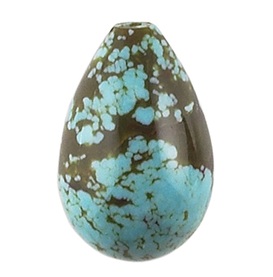 Turquoise, for all its resemblance to a brilliant rain-washed sky, or the clear waters of the Caribbean, is an earth color. Its greenish hues, touched with blue, may mimic the color of newborn grass. Spot the turquoise bluish colors, dotted with nature’s mix of golds and reds, on a hot house orchid. The color turquoise–or, better said, the many colors of turquoise–takes its name from the mineral that is extracted from the earth and formed into jewelry and art pieces. Though primarily seen in greenish blue, blue, or bluish green hues, turquoise can sometimes surprise you with its variety.
Turquoise, for all its resemblance to a brilliant rain-washed sky, or the clear waters of the Caribbean, is an earth color. Its greenish hues, touched with blue, may mimic the color of newborn grass. Spot the turquoise bluish colors, dotted with nature’s mix of golds and reds, on a hot house orchid. The color turquoise–or, better said, the many colors of turquoise–takes its name from the mineral that is extracted from the earth and formed into jewelry and art pieces. Though primarily seen in greenish blue, blue, or bluish green hues, turquoise can sometimes surprise you with its variety.
Where is Turquoise Found?
Turquoise is an old stone. It’s been found decorating the graves of mummified Egyptians and as part of ancient medical practices in India. Artists from the Sinai Peninsula to the American Southwest have used turquoise to create stunning jewelry and artwork. Yet turquoise is not created of itself, but of a combination of various minerals seeping into the cracks of rock formations and blending together through time and oxidization. Volcanic rock has a high level of oxide, and the stunning blue and green striations can sometimes be found there. Also, as far as turquoise goes, it seems the drier climate, the better.
Is All Turquoise the Color Turquoise?
You may feel like you are being led in a circle, but this does go back to what color is turquoise in the first place. Most people, when asked to choose, will select a brilliant blue (with maybe a touch of green) as the color turquoise. And they would be right. But so would those who select a rich green, perhaps touched with blue or yellow or orange. A really discerning viewer might also choose powder blue or amber, laced with black and declare that to be turquoise. And, yes, they too would be correct. The color of turquoise, the mineral, depends on which other minerals–and how much of each–have gathered together to form the turquoise gemstone. But, no–not all turquoise is the color usually associated with the name.
What are the Types of Turquoise?
When it comes to jewelry or art, or other turquoise you find marketed throughout the world, there are four basic types:
- Natural – As nature created it. This type of turquoise is mined, polished up, and goes directly into jewelry or art. No additives or chemical treatments.
- Stabilized – Close to natural, stabilized turquoise first goes through a stabilizing process that adds lustre and sealing to the stone
- Treated – Dipping turquoise in animal fat and then allowing it to dry changes the color, though not permanently. Less commercially favored treatment includes dying the stone in order to achieve a different, and more permanent, color.
- Synthetic – Synthetic turquoise is not turquoise at all (except in color), but an imitation. Sometimes a very good one. Howlite is one mineral that is often used to replicate turquoise, and is sometimes even sold as the gemstone itself by disreputable, or deceived, merchants.
How to Tell Real Turquoise from Synthetic?
It can be difficult. Imitation turquoise made from minerals such as howlite may appear more genuine than imitations made from plastic, and are thus harder to detect. Your first task in making sure the turquoise you are purchasing is genuine is buying only from a reputable dealer. Get a certification of authenticity stating that the gem you are buying is real, not processed, simulated or reconstituted turquoise. Other suggestions for determining real from synthetic is to look at the color distribution. If the color is too even, it could be an imitation gemstone. If you are in doubt, however, take the stone to a knowledgeable dealer and have them look at it, if at all possible.
Why is Turquoise so Popular?
It’s beautiful, of course; that’s one reason. But throughout the ages, turquoise has also been desired and revered by various cultures for other reasons. The meaning of turquoise, and what it brings to the wearer and holder, is surprisingly similar across cultures, borders and ethnicities. Many ancient protection amulets contained at least a bit of the turquoise stone. It was also thought to attune itself to the wearer, and allow the wearer to better attune themselves to the vagaries of life. And, of course, many felt–and still feel–that turquoise has healing properties, or at least help open a person up to healing energies. All in all, turquoise has a unique beauty, and long and fascinating history, and a place of prominence in many jewelry boxes and works of art.
Leave a Reply